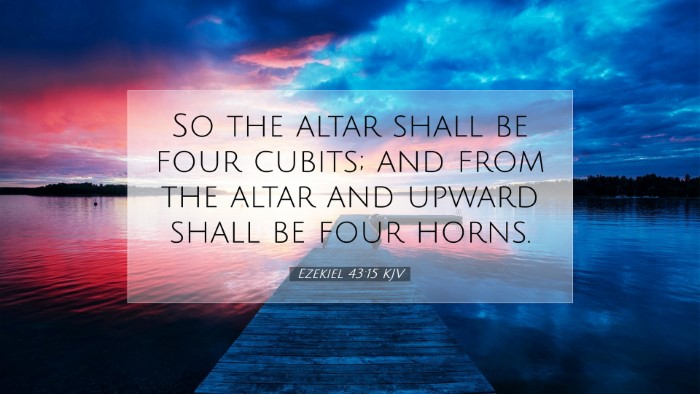Bible Commentary on Ezekiel 43:15
Ezekiel 43:15 (KJV): "The altar of wood, three cubits high, and the length thereof two cubits, and the breadth of it two cubits: the horns thereof shall be of the same."
Introduction
The vision of the temple in Ezekiel chapters 40-48 constitutes a pivotal aspect of the prophet's message and the restoration of Israel. In Ezekiel 43, the glory of the Lord returns to the temple, signifying divine acceptance and the restoration of worship. This verse specifically delineates the specifications of the altar, which plays a crucial role in the sacrificial system and the worship practices of the Israelites.
Significance of the Altar
The altar is symbolic of several theological concepts which are critical to understanding the sacrificial system in ancient Israel:
- Atonement: The altar served as the place where sacrifices were made to atone for the sins of the people.
- Divine Presence: It represents a meeting point between God and humanity, where worship and communion occur.
- Holiness and Separation: The design of the altar emphasizes the holiness of God and the need for purification before approaching Him.
Exegesis of Ezekiel 43:15
In this verse, the description of the altar as made of wood and its dimensions provides significant theological and practical insights:
- Material: The use of wood reflects God's dwelling among His people, suggesting a more personal and accessible form of worship.
- Dimensions: The specific measurements (three cubits high, two cubits long, and two cubits wide) indicate God's attention to detail in worship. It teaches the importance of order and precision in approaching God.
- Horns of the Altar: The mention of horns signifies power and might; it was customary to seek refuge at the horns during times of need, illustrating the altar as a place of safety for the repentant.
Theological Reflections
Pastors, students, and theologians can draw several key theological lessons from this verse:
- The Nature of God: This passage underscores the transcendence and immanence of God. While He is holy and set apart, He desires to dwell among His people.
- Worship Structure: The meticulous details in the specifications remind us of the need for reverence in worship practices. It calls for a thoughtful approach to our sacrificial offerings to the Lord.
- Christological Foreshadowing: The altar and its sacrifices ultimately point to the sacrificial work of Christ, who is our ultimate altar, providing redemption and atonement through His death on the cross.
Commentary Insights
Matthew Henry's Commentary
Henry emphasizes that the altar's design and dimensions are indicative of God’s order in worship. He highlights the importance of approaching God with a genuine heart, as the physical altar serves as a representation of spiritual realities. The imagery of wood reflects the humanity of Christ, who became accessible to humankind.
Albert Barnes' Commentary
Barnes notes the significance of the altar as a point of sacrifice and reconciliation. He points out that the horns of the altar symbolize a refuge for the sinner, stressing the accessibility of divine grace through the act of sacrifice. Barnes also elaborates on the parameters set for worship, indicating that it illustrates God’s holiness and His standard for acceptable offerings.
Adam Clarke's Commentary
Clarke provides a detailed analysis of the measurements, suggesting that they convey a deeper theological significance. He asserts that the dimensions reflect Christ’s mediatorial work and His authority over sin and death. Clarke also discusses the horns of the altar, connecting them to the broader theme of atonement in the Old Testament sacrificial system.
Conclusion
Ezekiel 43:15 serves as a profound reminder of God's desire for a relationship with His people through worship. The altar represents the various layers of meaning in approaching God—justice, mercy, and grace. As we reflect on these insights from esteemed commentators, let us be inspired to approach our worship with reverence, acknowledging both God's holiness and His desire to dwell among us through Jesus Christ.


